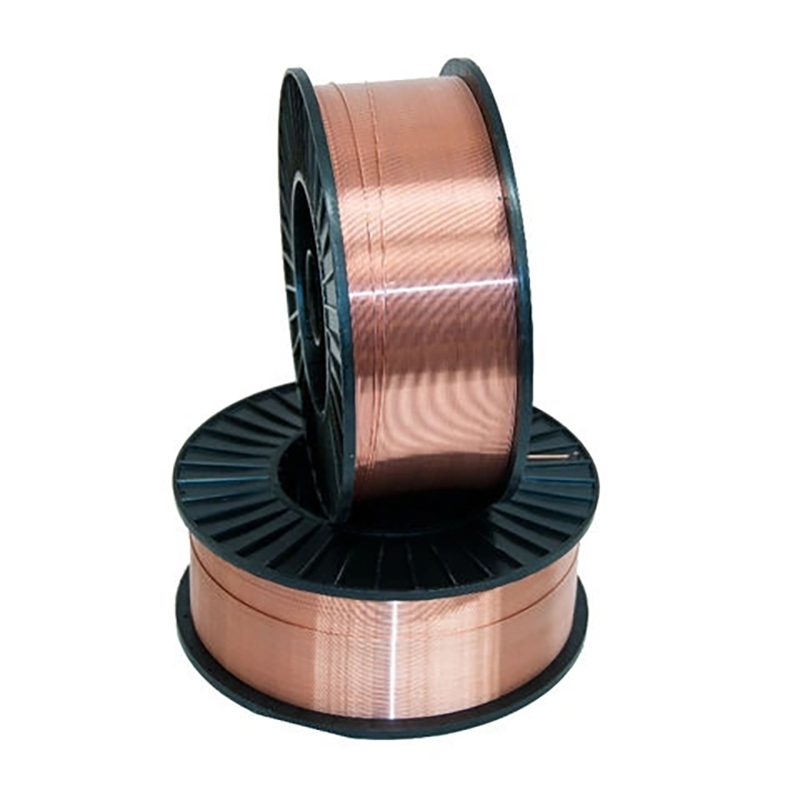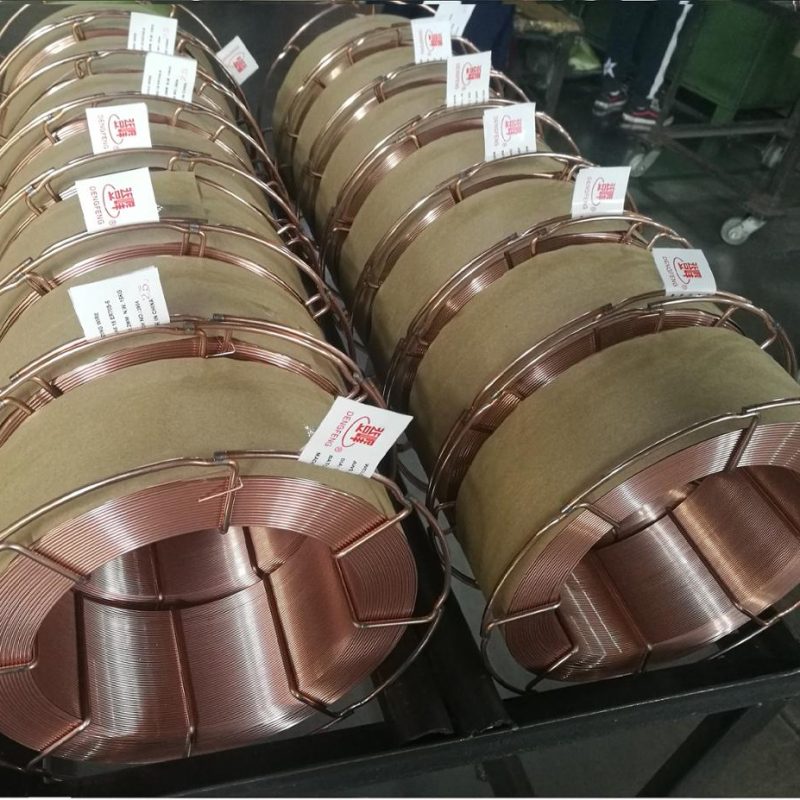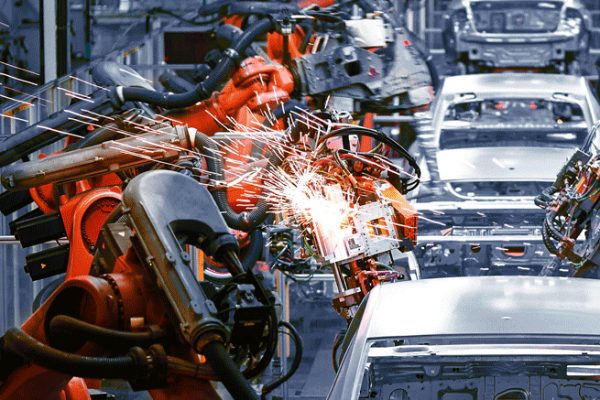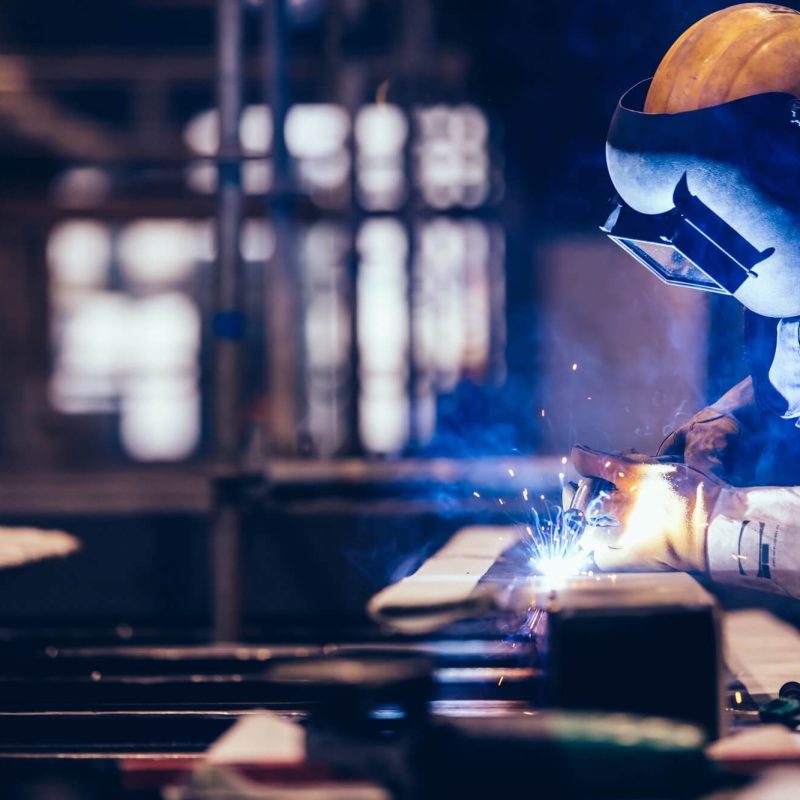
Gas-Shielded Welding Wire
WOERDE is an industrial welding consumables manufacturer that offers a wide range of welding wires. Our manufacturing facility in China produces high-quality Gas-Shielded Welding Wire for demanding industrial applications.
WOERDE also supplies various types of welding wires, including solid copper, flux-cored, stainless steel, aluminum, and copper welding wires, as well as electrodes. The Gas-Shielded Welding Wire is often used in automotive and shipbuilding applications, whereas the flux-cored and other types of wires are used in diverse industrial applications.
Gas-Shielded Welding Wire belongs to the family of arc welding consumables. It is named after its use of a shielding gas to protect the weld pool from atmospheric contamination. The Gas-Shielded Welding Wire has a similar function as other types of welding wires. The advantages of WOERDE’s Gas-Shielded Welding Wire include: reliable, easy to use, and requiring less maintenance.

ER80S-G

ER90S-G

ER100S-G

ER110S-G

All You Need To Know About Gas-Shielded Welding Wire
Gas-Shielded Welding Wire is a type of welding consumable that uses a shielding gas to protect the weld pool from atmospheric contamination. The design makes this wire suitable for both manual and automated welding processes. For many industrial applications, Gas-Shielded Welding Wire is used for its superior weld quality and productivity.
Because this type of welding wire offers excellent mechanical properties and is cost-effective, industries that require welding operations use them very often. Additionally, many industries prefer Gas-Shielded Welding Wire as it is easy to use and requires less maintenance. Gas-Shielded Welding Wire can be used in various welding processes, including Gas Metal Arc Welding (GMAW) and Flux Cored Arc Welding (FCAW).
This article provides you with everything you need to know about Gas-Shielded Welding Wire. What you’ll learn includes the uses of Gas-Shielded Welding Wire, its composition, the mechanism behind how it works, and the different types of Gas-Shielded Welding Wire. In the later end, you can check the difference between Gas-Shielded Welding Wire and other types of welding wires.
How Does Gas-Shielded Welding Wire Work?
Gas-Shielded Welding Wire primarily acts as a filler material in welding operations. The wire is fed through a welding gun and into the weld pool when it’s time to weld; it is parallel to the workpiece and the electric arc is established between the wire and the workpiece.
The diameter of this wire is typically smaller than the thickness of the materials being welded. When the welding operation starts, the wire melts and combines with the base metal to form the weld. Shielding gas is simultaneously released from the welding gun, protecting the weld pool from atmospheric contamination. The welding process continues with the wire being continuously fed and the shielding gas being continuously released.

What Are Gas-Shielded Welding Wires Used For?
Gas-Shielded Welding Wires are used in a wide range of industries that require welding operations. These could be the following:
- Automotive Manufacturing
- Shipbuilding Industry
- Construction Industry
- Aerospace Industry
- Pipeline Fabrication
- Heavy Equipment Manufacturing
- Railroad Construction
- Oil and Gas Industry
- Power Generation
- Metal Fabrication
Considerations When Buying Gas-Shielded Welding Wire
There are times when welding operations do not yield the desired results even if the welding wire used is of high quality. Why is this so? The answer lies in the knowledge and application of these welding wires. Understanding these considerations are part of achieving optimal welding results.
01.
Welding Process
Perhaps this is the most important consideration. Knowing the type of welding process narrows down the suitable welding wires to use. Furthermore, understanding the requirements of the welding process, such as the need for a shielding gas or the thickness of the materials being welded, are part of the considerations. That being said, Gas-Shielded Welding Wire is not suitable for welding processes that do not use a shielding gas.
02.
We Was Respond
The welding wire should be compatible with the materials being welded; otherwise, the weld may not be strong or durable. Incompatibility between the welding wire and the base metal can result in poor weld quality and potential weld defects.
03.
Wire Material
The material of the welding wire should be able to withstand the heat of the welding process and combine effectively with the base metal. Another fact to consider is the chemical composition of the welding wire.
04.
Quality and Manufacturer Reputation
The quality of the Gas-Shielded Welding Wire and the reputation of the manufacturer are also important considerations. High-quality welding wires are consistent in diameter, have a uniform chemical composition, and are free from surface defects. They also feed smoothly during the welding process, reducing the chances of wire feeding issues that can disrupt the welding operation.
Benefits of Using Gas-Shielded Welding Wire
Gas-Shielded Welding Wire offers several advantages that make it a preferred choice for many welding applications. Here are some key benefits:
Improved Weld Quality
The shielding gas protects the weld pool from atmospheric contamination, resulting in cleaner welds with fewer defects.
Reduced Spatter
The shielding gas stabilizes the arc, reducing spatter and resulting in less post-weld cleanup.
Better Mechanical Properties
Welds made with Gas-Shielded Welding Wire often have superior mechanical properties, including strength and ductility.
Increased Productivity
Higher deposition rates mean more metal can be deposited in less time, leading to increased productivity.
Versatility
Suitable for both manual and automated welding processes, and can be used in a variety of welding positions.
Cost-Effective
Despite the need for a shielding gas, the overall efficiency and productivity gains often make Gas-Shielded Welding Wire a cost-effective choice for many welding operations.
Technical Specifications of Gas-Shielded Welding Wire for MIG and TIG Welding
Understanding the technical specifications of our Gas-Shielded Welding Wire for MIG and TIG welding can help you make an informed decision. Here are the key details:
| Specification | MIG Welding | TIG Welding |
|---|---|---|
| Wire Diameter | Commonly ranges from 0.8mm to 1.6mm. | Commonly ranges from 1.0mm to 3.2mm. |
| Weight | Typically sold in spools of 15kg and 20kg. | Typically sold in straight lengths of 1m, packaged in 5kg or 10kg boxes. |
| Chemical Composition | Composed of a steel core and additional alloying elements. Exact composition can vary based on the specific type of wire. | Similar to MIG, but may have slightly different alloying elements to suit the TIG process. |
| Mechanical Properties | Offers excellent tensile strength, yield strength, and elongation properties. Specific values can vary based on the type of wire and welding conditions. | Similar to MIG, but may have slightly different properties due to the different welding process. |
| Shielding Gas | Typically used with a mixture of Argon and Carbon Dioxide gases. The exact mixture can vary based on the material being welded. | Typically uses pure Argon as the shielding gas. |
Please note that the exact specifications can vary based on the specific type of Gas-Shielded Welding Wire and the welding conditions. Always refer to the product data sheet or consult with our technical team for the most accurate and up-to-date information.
Safety and Handling Instructions for Gas-Shielded Welding Wire
Using Gas-Shielded Welding Wire safely and effectively requires understanding and following certain guidelines
01.
Proper Welding Technique
Use a drag technique while welding. Maintain a steady and appropriate travel speed to prevent the weld pool from getting ahead of the arc, which could lead to slag inclusions.
02.
Correct Stick-Out
Improper stick-out can result in burnback, worm-tracking, incomplete slag coverage, and difficult slag removal. Check the stick-out recommendations for each wire. Depending on the wire diameter and type, the recommended stick-out may exceed 2 inches.
03.
Storage of Welding Wire
Store flux-cored wires in a clean, dry area. Exposure to moisture or other contaminants can damage the wires, resulting in poor weld quality. For wires in use, remove the spool from the wire feeder at night and store it in a plastic bag to reduce chances of problems from moisture exposure.
04.
Temperature Considerations
Maintain the same temperature in the storage area as in your welding area. Condensation can form on wires if you move them from a cold storage room to a warm fabrication environment. This can lead to rusting of the wire and potential wire feeding problems or porosity in the weld.
05.
Safety Equipment
Always use appropriate safety gear, including welding helmets, gloves, and protective clothing. Ensure your work area is well-ventilated to prevent the accumulation of potentially harmful fumes.
06.
Training
As with any new welding process or filler metal, training is an important step toward success. If you’re new to using gas-shielded flux-cored wires, you may want to seek out additional training or certifications to help you master the process.
Please note that the exact specifications can vary based on the specific type of Gas-Shielded Welding Wire and the welding conditions. Always refer to the product data sheet or consult with our technical team for the most accurate and up-to-date information.
Request Your Free WOERDE Welding Wire Sample
Experience WOERDE’s superior welding wires firsthand. Fill out our online form to request a free sample today. Discover why global businesses trust WOERDE.


